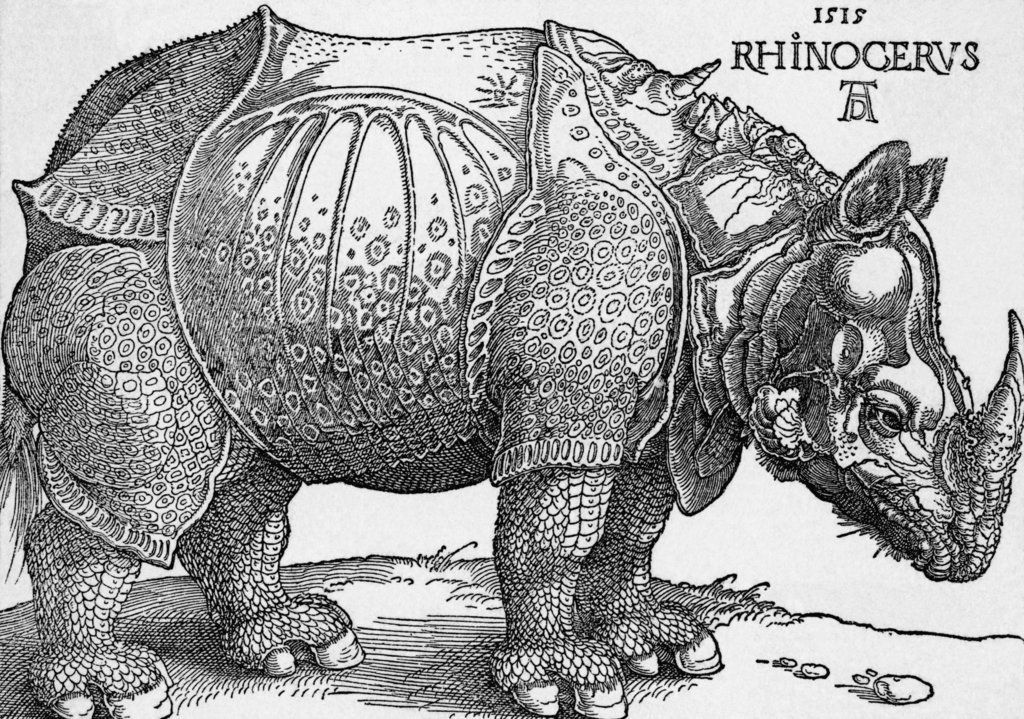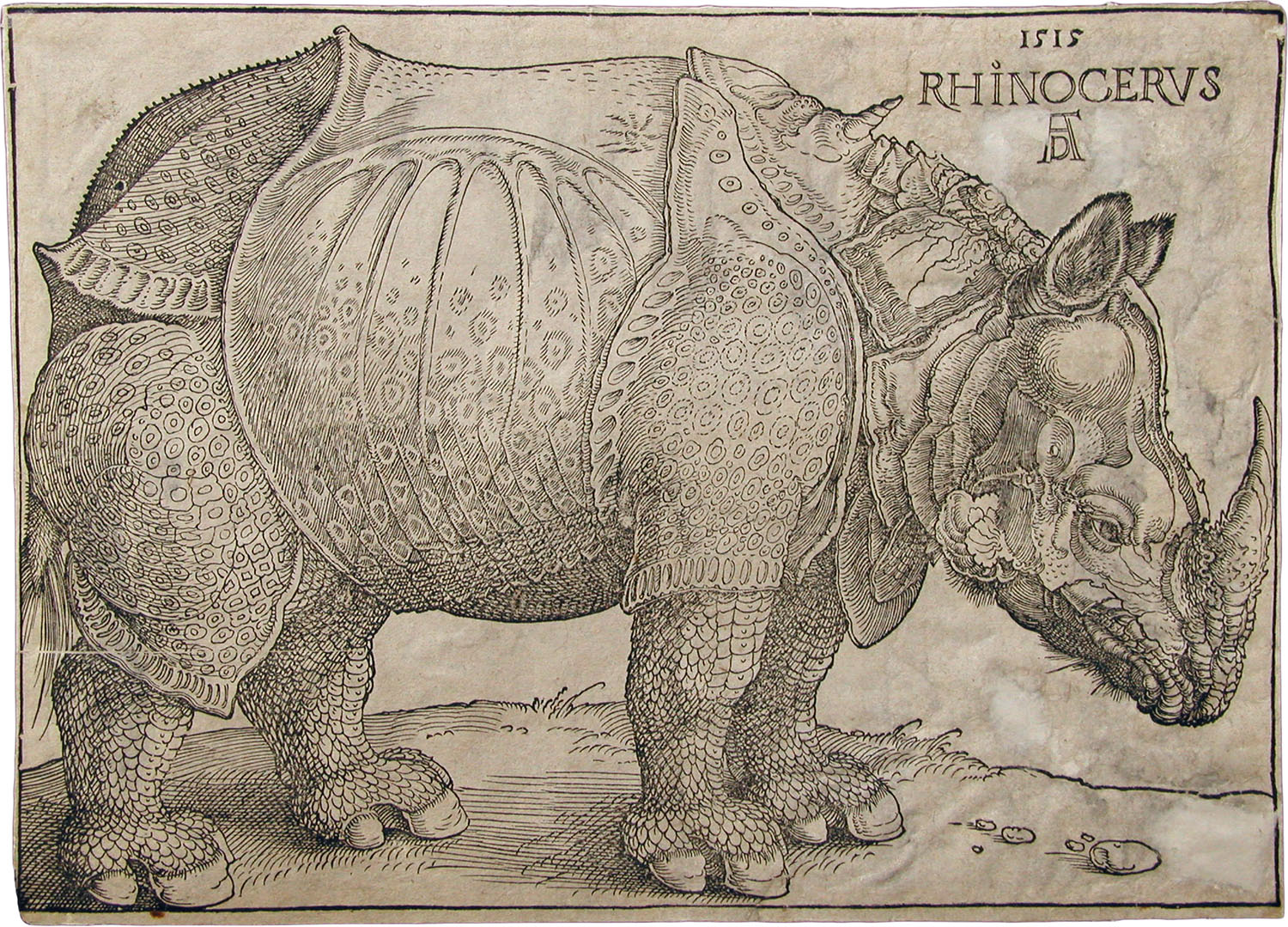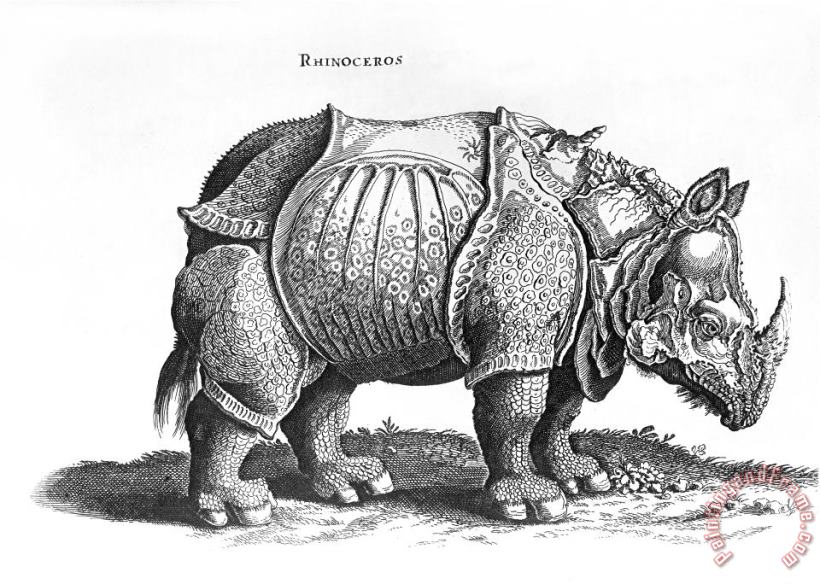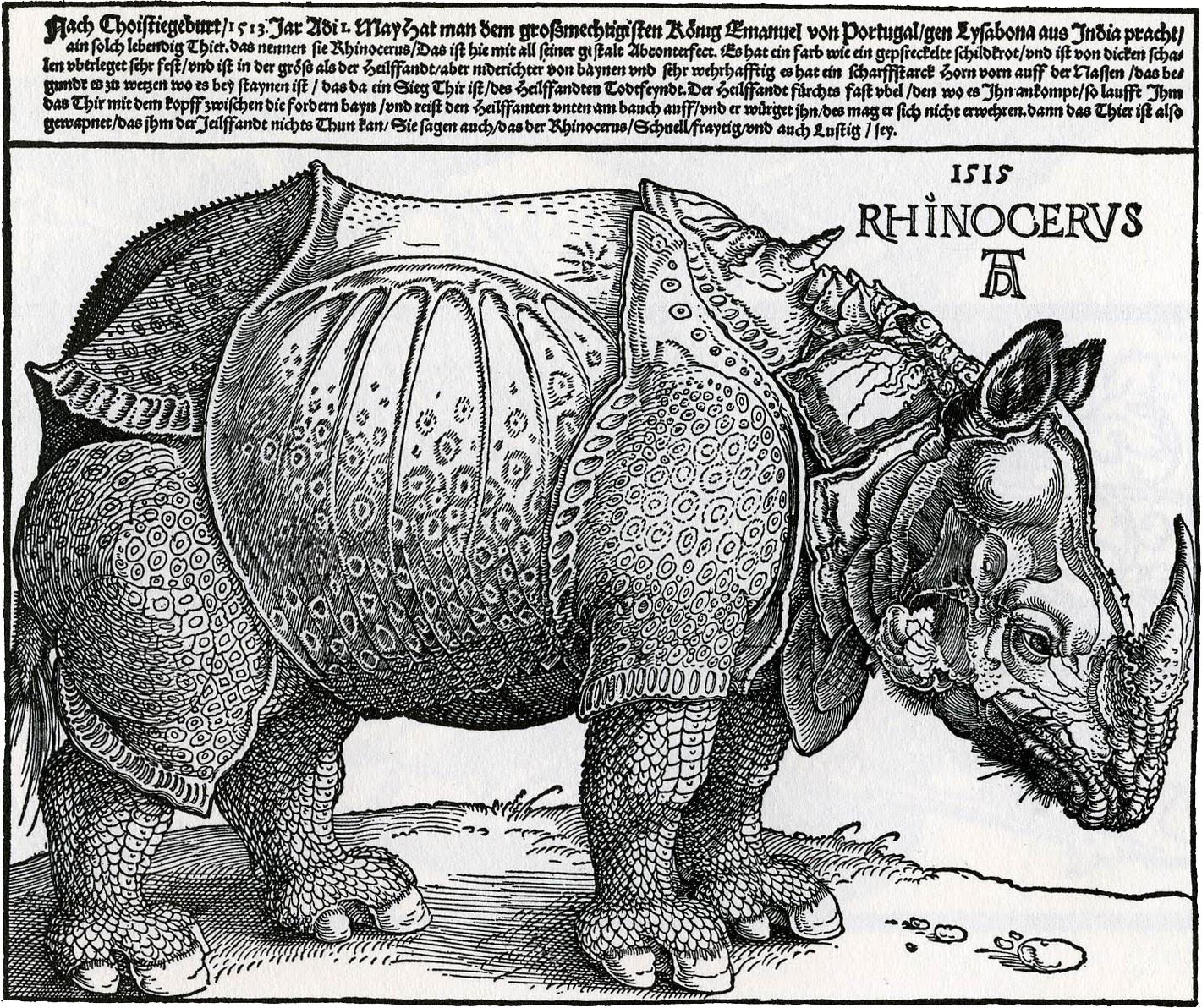
Albrecht Dürer (14711528), Le Rhinocéros, gravure sur bois, épreuve d’un tirage vers le milieu
Description. This woodcut of an Indian rhinoceros by Dürer has proved endlessly popular since its first publication in 1515. Eight editions of the print were taken from the original woodblock over the course of a century or so; this impression is one of a large number printed in the sixteenth century, after Dürer's death.

Related image Albrecht durer, Renaissance art, Animal drawings
Title: The Rhinoceros. Artist: Albrecht Dürer (German, Nuremberg 1471-1528 Nuremberg) Date: 1515. Medium: Woodcut. Dimensions: image: 8 3/8 x 11 5/8 in. (21.3 x 29.5 cm) trimmed to block line except at top sheet: 9 3/8 x 11 3/4 in. (23.8 x 29.9 cm) Classification: Prints. Credit Line: Gift of Junius Spencer Morgan, 1919. Accession Number: 19.

Kurtosis Ideas Albrecht Dürer's Rhinoceros
The Indian rhinoceros is the world's fourth largest land animal, but can run up to 34 miles per hour This print of a rhinoceros was created by Albrecht Dürer, the most famous artist of his day.

Le Tampographe The Stampographer — Rhinocéros de Dürer Rhinocéros, Encreurs, Tampons
Durer's Rhinoceros. Dürer's 'Rhinoceros' (1515). Woodcut, printed in Nuremberg. The tiny island of St Helena, in the middle of the South Atlantic, is famous above all as the open prison for.

Le Rhinoceros de Durer Lion sculpture, Art, Rhinoceros
Details. Title: The Rhinoceros. Creator: Albrecht Dürer. Date created: 1515. Physical Dimensions: sheet (trimmed to image): 23.5 x 29.8 cm (9 1/4 x 11 3/4 in.) Provenance: Kupferstichkabinett, Kunstmuseum Basel (Lugt 222a) Medium: woodcut on laid paper. Explore museums and play with Art Transfer, Pocket Galleries, Art Selfie and more. Google.

Pin on Jules Verne & gravures Victorienne
Take a look at Dürer's rendition of the rhinoceros: "The Rhinoceros" ( 1515) by Albrecht Dürer. Courtesy of National Gallery of Art, Washington, DC. Close observers will notice that Dürer's rhinoceros broadly resembles what an actual rhinoceros looks like. Notice, however, that Dürer took a number of liberties with his rendition.

ihlapi Dürer’s Rhinoceros Albrecht Dürer,...
The animal is called rhinoceros in Greek and Latin but in India, gomda (note 1). In his creative interpretation, Dürer illustrates this strongly built mammal with a thick skin of armor plating. He highlights the heavy texture of the animal's body and renders it even more apparent through the use of a woodblock.
Carol Ann Kauffman's VISION and VERSE The Artist ALBRECHT DURER
Monster hit. Albrecht Dürer had a showman's instincts for killer subject matter. When history's greatest print-maker decided to create an image of the rhinoceros that had visited Lisbon in.

Daily Lazy The Rhinoceros
Dürer's Rhinoceros is the name commonly given to a woodcut executed by German artist Albrecht Dürer in 1515. Dürer never saw the actual rhinoceros, which was the first living example seen in Europe since Roman times.Instead the image is based on an anonymous written description and brief sketch of an Indian rhinoceros brought to Lisbon in 1515. Later that year, the King of Portugal, Manuel.

Albrecht Dürer THE RHINOCEROS Animal art, Albrecht durer, Art prints
Coste, C. Anciennes figurations du Rhinocéros de l'Inde. A propos du frontispice de l'ouvrage de Wihelm Pison "De Indiae utriusque re naturali et medica", édité à Amsterdam en 1658. In Acta Tropica, 3(2), 1946, p. 116-129 [P203] Dathe, H. Ein weiteres 'Durer-Hornlein' beim Breitmaulnashorn. In Zoologische Garten, 60/5, 1990, p. 322 [P3987]

Salon de l’estampe le rhinocéros de Dürer, en couleur Ad vivum
Bibliographic references. Rowlands 1993 / Drawings by German artists and artists from German-speaking regions of Europe in the Department of Prints and Drawings in the British Museum: the 15thC & 16thC by Artists born before 1530 (195) Strauss 1974 / The Complete Drawings of Albrecht Dürer (1515/57) Winkler 1936-9 / Die Zeichnungen Albrecht.

Pin by Art Class on Animal printable decor Albrecht durer, Weird creatures, Rhinoceros
The rhinoceros's horn touches the border to the right and its hindquarters the left. Its left foot, farther from us, stands slightly ahead of its right hoof. Its front feet are close together and its head is lowered. Chunky, armor-like plates covering its body are patterned in some areas, especially on its legs and belly, with rings and dots.

Woodcut By Albrecht Dürer 1515 Banque d'image et photos Alamy
The Legacy of Dürer's Rhinoceros. Dürer's woodcut print of a rhinoceros is as iconic as it is inaccurate. In this article we explore the legacy of this artwork and how it shaped public perception for more than 200 years after its creation. In 1515, German artist Albrecht Dürer created the woodcut without ever actually seeing a rhino for.

Albrecht Durer Rhinoceros No 76 From Historia Animalium By Conrad Gesner painting Rhinoceros
Durer's Rhinoceros. A History of the World in 100 Objects The Threshold of the Modern World (1375-1550 AD). This print of a rhinoceros was created by Albrecht Dürer, the most famous artist of.

Albrecht Dürer HuffPost
For this was the rhinoceros portrayed by Albrecht Dürer in his famous woodblock print of 1515. Dürer, one of the most established and famous artists of the day, was like most people in Europe: he never actually saw the rhinoceros. He relied on a written description and sketch sent from Lisbon. Many more people ended up seeing his print than.

"Nashorn", stift von Albrecht Durer (14711528, Germany) Рисунки животных, Альбрехт дюрер
The rhinoceros' horn is much larger and imposing than in nature and, indeed, Durer shows the animal as having a second, smaller, spiral horn on its back. Durer's text at the top of the woodcut confirms the impression that the image gives of a powerful fighting beast feared even by elephants. He also assures the viewer that "This is an.